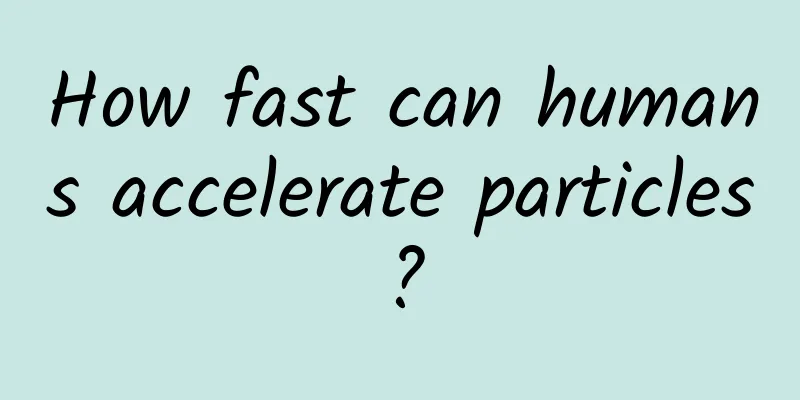How fast can humans accelerate particles?

|
The only martial arts in the world that cannot be defeated is speed! What is the fastest speed in the universe? I believe many people know that it is the speed of light (here only the speed of matter is considered, not the speed of the expansion of the universe, etc.)! About 300,000 kilometers per second! At this speed, a beam of light can circle the earth's equator seven and a half times per second! Sitting on the ground, it travels 60 billion kilometers a day! What is the second fastest speed? As the saying goes, there is no first in literature and no second in martial arts. The speed of an object can only be the fastest, not the second fastest! However, in order to study the origin of the universe and the composition of matter, humans have built particle accelerators and particle colliders to accelerate extremely small particles to very fast speeds, close to the speed of light, and then let them collide head-on, causing the particles to break apart and fly in all directions. By collecting these scattered particles and analyzing their behavior, the properties of the colliding particles can be inferred. Schematic diagram of LHC particle collision, reconstructed based on real collision data Source: https://home.cern/news/news/accelerators/lhc-experiments-join-forces-zoom-higgs-boson) How fast can we accelerate particles? Can we reach the speed of light? Unfortunately, this is not possible. It is forbidden by nature! The relationship between the energy and speed of a particle is: m is the rest mass of the particle, c is the speed of light, and v is the speed of the particle. It can be seen that if a particle with a non-zero rest mass, such as an electron, proton, atomic nucleus, etc., reaches the speed of light, then its energy will be infinite, which is obviously impossible. Of course, although it cannot reach the speed of light, it can continue to approach the speed of light. As long as enough energy can be provided, the speed of the particle can be close enough to the speed of light. The relationship between particle energy and speed (ratio to the speed of light) drawn by the author The world's largest particle collider is the Large Hadron Collider (LHC) at CERN. It accelerates protons, or hydrogen nuclei. How fast can it go? The fastest it can reach is 99.9999991% of the speed of light, which is very close to the speed of light! What about accelerating electrons? The Stanford Linear Accelerator (SLAC) can accelerate electrons to 99.999999995% of the speed of light. Although this speed is much faster than the protons mentioned above, it is actually easier to accelerate electrons than protons because the mass of electrons is smaller, only 1/1800 of the mass of protons. According to the energy formula above, at the same energy, the greater the rest mass, the smaller the speed. In addition to electrons and protons, there is another type of accelerator that accelerates the nuclei of various atoms. Nuclei are much heavier than a simple proton or electron. For example, the Relativistic Heavy Ion Collider (RHIC) at Brookhaven National Laboratory in the United States can accelerate the nuclei of gold to 99.995% of the speed of light. Although it is not as fast as the speed of the above-mentioned protons and electrons, it is still very fast. In principle, all atomic nuclei can be accelerated to a point close to the speed of light, but the speed will naturally vary depending on their mass. After accelerating these particles, they will naturally collide with each other. So how do two atomic nuclei collide? Is it like this: Image source: https://sciencesprings.wordpress.com/tag/eic-electron-ion-collider-in-development/ Obviously not, but this: Simulation of relativistic heavy ion collision Image source: https://madai.phy.duke.edu/indexaae2.html?page_id=503 This happens because the atomic nucleus has a certain volume, and the speed is close to the speed of light, so a contraction effect will occur in the direction of the speed, and a spherical particle will become a pancake! However, this is not the limit. A larger and longer accelerator often means higher energy and faster speed. Many people may envision accelerators that will circle the Earth, the solar system, or even the Milky Way in the future. Currently, these are still science fiction. Let's take a look at the accelerators and colliders that are currently being planned or built. The International Linear Collider (ILC) accelerates and collides positrons and electrons: positrons and electrons are accelerated by a linear accelerator of about 11 kilometers (not a circular one). It is expected to accelerate electrons to 250 GeV, and the speed reaches 99.999999999979% of the speed of light, a total of 11 nines after the decimal point! Higher than the SLAC mentioned above! Once built, it will become the most powerful electron accelerator and collider in history. In recent years, China has also been promoting a Circular Electron-Positron Collider (CEPC), which is a circular accelerator with a target energy of 125 GeV and an electron speed of 99.99999999916% of the speed of light, which is also 11 nines! In addition, according to the plan, if everything goes well, CEPC may be upgraded to a Super Proton-Proton Collider (SppC) in the later stage. The second phase of the project is expected to accelerate protons to 75 TeV, which is much higher than the current LHC's 7 TeV. By then, the speed of protons will be able to reach 99.999999992% of the speed of light, which is 10 nines. This speed is really fast enough! CEPC design concept diagram Image source: https://new.qq.com/omn/20191210/20191210A0G0BH00.html I need to add one more thing here: the greater the energy of the particles, the better, and the faster the speed, the better. It depends on the research goal. For example, the future heavy ion collider is not to increase the collision energy, but to reduce the collision energy: high-energy collisions are relatively easy, while low-energy collisions are difficult. After talking about so many high-energy particle collisions, some of you may be worried. With such high particle energies, will the collisions generate huge amounts of energy and destroy the Earth? For example, will a micro black hole be created to swallow the Earth? In fact, this worry is unfounded. The high energy of particles refers to the high energy of single particles, but the total number of particles in the collider is actually very small compared to the number of particles contained in macroscopic matter, so the total energy is also small. The total energy of your breath is even higher than the total energy of particles in the collider. Of course, the average energy of the air molecules you blow out is low and cannot be used for collision! Moreover, the energy that humans have achieved by accelerating particles may seem quite high, but when looking at the universe, it is still a small one. In 1991, people detected a proton from the universe, whose speed was 99.9999999999999999999999951% of the speed of light, with 23 nines after the decimal point. It is much higher than the speed and energy that humans can achieve at present! The energy of this particle is so high that we call it "The Oh-my-god particle" (it was originally called "god damn particle", but it was changed because it was not civilized). In the past 4.5 billion years, there must have been many high-energy particles like this, but the Earth has not been affected. Humans have never observed any planet in the universe being destroyed by a high-energy particle, so don't worry, the collider cannot destroy the Earth! Produced by: China Science Expo x Zhihu Author: Ziqian (Excellent Answerer of Physics on Zhihu) The article only represents the author's views and does not represent the position of China Science Expo This article was first published in China Science Expo (kepubolan) Please indicate the source of the public account when reprinting Please indicate the source of the reprint. Reprinting without authorization is prohibited. For reprint authorization, cooperation, and submission matters, please contact [email protected] |
Recommend
SaaS Enterprise Promotion and Customer Acquisition Guide: Finding the Best Channel
Buffett said: If you have 40 wives and concubines...
There are so many museums, how are they classified?
When people are free or traveling, many of them t...
Pushing differentiation to the extreme: OPPO N3 full experience with electric rotating lens
There are not many domestically produced smartpho...
Can Japan's declining home appliance industry regain its "former glory"?
Japanese home appliance manufacturers once led th...
China Meteorological Administration issued three warnings in a row (full text)
China Meteorological Administration issues three ...
Mobile Internet Channel Promotion Methodology (with case studies)
Friends often ask me that they spent a lot of mon...
What exactly is the human hemipulmonary virus that has become a hot topic, and how can we deal with it?
Recently, the topic #国产发生人体块病毒菌# suddenly became ...
There are more than 600 million patients in my country! Severe cases can cause blindness! This trouble can be prevented by getting more sun
At present, there are 1.4 billion myopic patients...
Nanjing's high-end tea service, it's very prestigious to go with your childhood friends
Recommendations for places to taste tea in Jiangn...
A summary of new ways and tactics to make articles popular on Xiaohongshu!
This year’s Double Eleven has ended, but Xiaohong...
Did a main-belt comet collide with the source of life?
Where does the water on Earth come from? Recently...
"Xuelang Plan" from entering to selling your own courses, a full process tutorial
Course Contents: 1. 2022 Xuelang entry super deta...
After the COVID-19 test turns negative, should we replace toothbrushes, lipsticks and other daily necessities? The December scientific rumor list is released. Let's hear what the experts say.
1. "After the COVID-19 test turns negative, ...
Data analysis for event promotion, learn it now
PSM is not suitable for all marketing scenarios. ...









